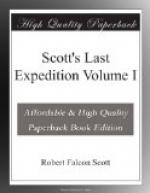Both morning and afternoon we have had brilliant sunshine, and this afternoon all the after-guard lay about on the deck sunning themselves. A happy, care-free group.
10 P.M.—We made our start at eight, and so far things look well. We have found the ice comparatively thin, the floes 2 to 3 feet in thickness except where hummocked; amongst them are large sheets from 6 inches to 1 foot in thickness as well as fairly numerous water pools. The ship has pushed on well, covering at least 3 miles an hour, though occasionally almost stopped by a group of hummocked floes. The sky is overcast: stratus clouds come over from the N.N.E. with wind in the same direction soon after we started. This may be an advantage, as the sails give great assistance and the officer of the watch has an easier time when the sun is not shining directly in his eyes. As I write the pack looks a little closer; I hope to heavens it is not generally closing up again—no sign of open water to the south. Alas!
12 P.M.—Saw two sea leopards playing in the wake.
Thursday, December 29.—No sights. At last the change for which I have been so eagerly looking has arrived and we are steaming amongst floes of small area evidently broken by swell, and with edges abraded by contact. The transition was almost sudden. We made very good progress during the night with one or two checks and one or two slices of luck in the way of open water. In one pool we ran clear for an hour, capturing 6 good miles.
This morning we were running through large continuous sheets of ice from 6 inches to 1 foot in thickness, with occasional water holes and groups of heavier floes. This forenoon it is the same tale, except that the sheets of thin ice are broken into comparatively regular figures, none more than 30 yards across. It is the hopefullest sign of the approach to the open sea that I have seen.
The wind remains in the north helping us, the sky is overcast and slight sleety drizzle is falling; the sun has made one or two attempts to break through but without success.
Last night we had a good example of the phenomenon called ’Glazed Frost.’ The ship everywhere, on every fibre of rope as well as on her more solid parts, was covered with a thin sheet of ice caused by a fall of light super-cooled rain. The effect was pretty and interesting.
Our passage through the pack has been comparatively uninteresting from the zoologist’s point of view, as we have seen so little of the rarer species of animals or of birds in exceptional plumage. We passed dozens of crab-eaters, but have seen no Ross seals nor have we been able to kill a sea leopard. To-day we see very few penguins. I’m afraid there can be no observations to give us our position.
Release after Twenty Days in the Pack
Friday, December 30.—Obs. 72 deg. 17’ S. 177 deg. 9’ E. Made good in 48 hours, S. 19 W. 190’; C. Crozier S. 21 W. 334’. We are out of the pack at length and at last; one breathes again and hopes that it will be possible to carry out the main part of our programme, but the coal will need tender nursing.




